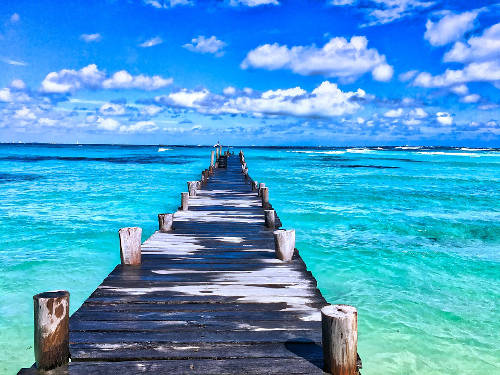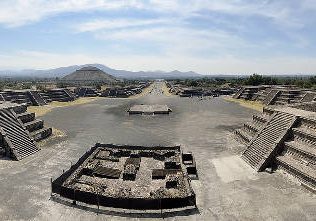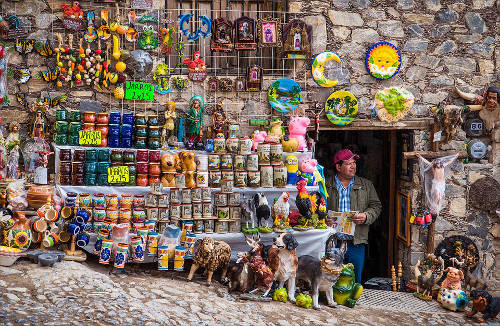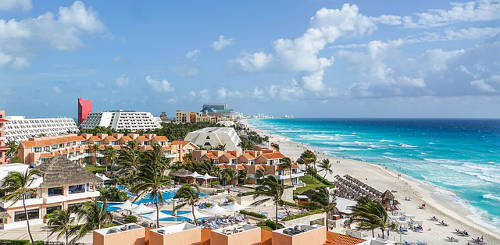Mexico
General
Independent democratic federal republic, officially the United Mexican States (Estados Unicos Mexicanos). Covering almost two million square kilometres, Mexico is the sixth largest state in the Americas, bordered to the north by the United States, to the southeast by Guatemala, Belize and the Caribbean, to the south and west by the Pacific, and to the east by the Gulf of Mexico. Population 120 million.
The Tropic of Cancer (approximately where the red marker is on the map) divides the country - north of the line is temperate, and the south more tropical, with fairly constant temperatures varied only by height above sea level. Mexico has a variety of weather systems. Mexico can get serious hurricanes between August and November..
Mexico is fourth in the world for biodiversity and passed a comprehensive climate change bill in 2012. It set a target of generating 35% of its energy from renewable sources by 2050. In 2016, this was increased to 50% renewable generation by 2025.
Most people head for the area round Cancun in the Yucatan peninsula, in the Gulf of Mexico by the border of Guatemala. There are some stunning marine reserves here.
Currency: Peso (MXN). 1MXN = £0.04. = €0.05 = US$ 0.05
Flight time London to Mexico City: 11 hrs 30 mins.
Flight time London to Cancun: 10 hours 10 mins.
Time in Mexico City: UTC - 6 hours winter), UTC - 5 (summer). There are four time zones in Mexico.
Entry requirements: valid passport, return ticket.
Visas? Travelling for business or tourism for under 180 days, you don't need a visa if you're from USA, Japan, UK, Canada, or the European Schengen Area, but you do need a tourist card which you can get on arrival. It's not entirely straightforward, and you should do some checking. This website is a good starting place: https://www.mexperience.com/do-i-need-a-visa-to-visit-mexico/
The UK government has some good advice too:
https://www.gov.uk/foreign-travel-advice/mexico/entry-requirements
(written August 2017)



Climate charts (for Cancun)
When to go to Mexico? Lonely Planet classifies three periods: the high season (Dec - April), with lots of visitors from colder countries, and the usual Christmas and Easter rush: the shoulder season (July and August), vacation time for many Mexicans and foreigners, when prices go up: and the low season (May, June, Sep - Nov): May and June see peak temperatures, September is the heart of the hurricane season. You don't always get hurricanes, but they can be nasty. During this time there is a lot of rain in the Gulf and Pacific Coasts. https://www.lonelyplanet.com/mexico/weather
UK Foreign office is worth checking - the situation in Mexico is generally calm but can be variable. There is crime on occasions, and you need to be vigilant. The Foreign Office has also warned of the risk of Zika virus transmission. https://www.gov.uk/foreign-travel-advice/mexico
In the hurricane period, you could check the US National Hurricane Centre for advice. http://www.nhc.noaa.gov
Sea temperature - 27°C to 29°C all year round (that’s warm). And eight hours' average daily sunshine in Cancun.
Generally, snorkelling in Mexico has an excellent reputation, and is well worth checking out.
http://traveltips.usatoday.com/snorkeling-mexico-62833.html
More information on climate - http://www.holiday-weather.com/cancun/averages/
Mexico trip 2009
We stayed in Las Palapas, Playa del Carmen for three days, en route to Belize. We were going to return but there was an outbreak of swine flu and we had to cancel the second leg.
We went on a day-long snorkel trip to the reef - a circular trip which was quite hard work, but very rewarding. If you're a weak snorkeller, it might be worth checking the difficulty of the tour before you go out.
Playa del Carmen has a good reputation for snorkelling, and would be on our itinerary for a return trip. We'd like to see the cenotes (from the Mayan word "Dzonot", meaning sacred well). Some snorkel trips arrange visits to these, so you can check out the stalagmites and stalactites.
The Riviera Maya (south of Cancun to south of Tulum) is the home of the second largest barrier reef in the world - the Mesoamerican, a 1,000-km reef stretching from the Yucatan down to Belize, Guatemala and Honduras. Much of it is designated as National Marine Park, including Puerto Morelos, Cozumel Island, Xcalak and Islas Mujeres.
The USA Today website (above) is worth checking out for general information about snorkelling off Yucatan. For an exhaustive list of 53 sites, 18 boat trips and 88 firms supplying snorkelling-related services, go to http://caribya.com/yucatan.peninsula/snorkeling/.
Snorkelling appears to be well-organised and popular here. Cancun has many sandy beaches, but there are still good snorkelling spots available. The Islas Mujeres, off Cancun, are recommended, and have their own snorkelling tour operator: http://islamujeres-snorkeling.com. Also recommended is Tulum, along the coast, and the island of Cozumel, off Playa del Carmen - though we haven't been there ourselves. Yet.
We have wanted to go to Cancun since we heard about the opening of the Cancun Underwater Museum in 2010. This has a total of 500 sculptures, mostly by British sculptor Jason deCaires Taylor.
The idea of the museum was to protect the largest coral reef in Cancun, which was being damaged by snorkellers and divers. Artificial reefs grow around shipwrecks, and Taylor had been pioneering the idea of growing reefs round statues in the Molinere Underwater Sculpture Park in Grenada. Museum director Jaime Gonzales Canto worked with Taylor to bring the idea to Cancun. These are one of Taylor's photographs on the right.
As the sculptures are made with pH-neutral cement, coral, seaweed and algae are able to grow. Stable structures make for ideal reefs. This project has been amazingly successful. The statues have holes in them, so that marine wildlife can feed off the coral, which is increasing. In time, the statues will be covered and barely visible.
750,000 visitors a year visit the reefs in this area, so the museum forms a welcome way of alleviating pressure elsewhere. You can snorkel over the statues, or see them from a glass-bottom boat.

Would we go there? Definitely - it's on the list.

Usual warning: we have made every effort to make sure this information is correct and up-to-date, but you need to check it all yourself.
© Garreg Lwyd Ltd 2018
Do you have any comments, or recommendations? Send us a message! We'd love to hear from you...
